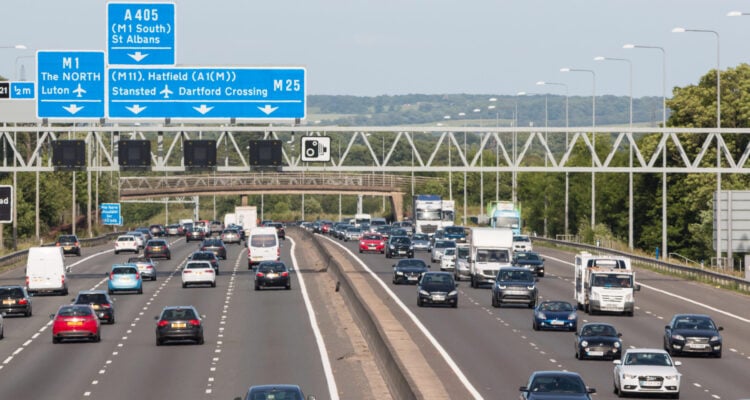Motorways are the arteries of Britain’s road transport network. Yet for many motorists, some routes offer more headaches than help. We have analysed user feedback, congestion statistics, accident data, and journey time reliability to identify the worst-performing motorways in the UK. This is not just about anecdotal frustration — it’s a detailed assessment of where the infrastructure is failing drivers and what it means for road safety and efficiency.
M25: The Perennial Congestion Capital
The M25, orbiting Greater London, frequently ranks as the most congested motorway in Britain. Despite its crucial role in linking major radial routes, it is notorious for:
- Excessive congestion, particularly between Junctions 10 (A3) and 16 (M40), where average speeds during peak hours drop below 25 mph.
- Unpredictable delays caused by high traffic volumes, frequent incidents, and poor diversion options.
- Ongoing smart motorway upgrades that often contribute to bottlenecks rather than alleviating them.
The M25’s design was never intended to handle over 200,000 vehicles daily — a capacity it regularly exceeds. The impact on haulage, business logistics, and commuter stress is profound.
M6: Infrastructure Bottlenecks and Regional Inefficiency
The M6 is the UK’s longest motorway, stretching from Rugby to Gretna. Its poor performance is largely due to:
- Narrow carriageway sections, especially between Junctions 13 and 15 near Staffordshire.
- Frequent closures due to roadworks and incidents.
- Congestion around Birmingham and Manchester, where the motorway interfaces with other major routes.
Although smart motorway schemes between Coventry and Wigan have promised smoother flows, drivers consistently report unreliable journey times and limited emergency refuge areas.
M62: Weather Woes and Engineering Limitations
Spanning the Pennines, the M62 connects Liverpool to Hull and serves as a vital trans-Pennine route. However, its design is hampered by:
- Exposure to severe weather, especially near Saddleworth Moor where closures due to snow and fog are common.
- Steep gradients and high-altitude sections causing slow-moving HGVs and congestion.
- Unfinished smart motorway upgrades leaving inconsistent lane usage and unclear signage.
The M62’s mix of urban and remote stretches demands different safety and capacity strategies — something current infrastructure fails to deliver.
M60: Manchester’s Inner Ring with Outer Problems
Designed to ease central Manchester traffic, the M60 has instead become a flashpoint for:
- Chronic congestion, especially between Junctions 7 and 18.
- Overloaded slip roads, leading to regular tailbacks onto local roads.
- A lack of viable alternative routes, meaning minor incidents cause major ripple effects.
Despite substantial investment, the M60 fails to meet modern expectations for orbital motorway efficiency.
M4: Ageing Artery in the South
Linking London to South Wales, the M4 has historically been a key corridor for trade and tourism. However:
- Sections around Reading and Bristol suffer from daily gridlock.
- Delays caused by the Brynglas Tunnels near Newport have long been a strategic weakness.
- Smart motorway sections are inconsistent, causing confusion and driver hesitation.
The cancellation of the proposed M4 relief road around Newport has left a major infrastructure gap unaddressed.
Motorway Performance Ratings
| Motorway | Main Issues | Average Peak Speed | Notable Chokepoints |
| M25 | Congestion, delays | 23 mph | J10–J16, J5–J7 |
| M6 | Closures, capacity | 29 mph | J13–J15, Birmingham |
| M62 | Weather, terrain | 31 mph | Saddleworth, J26–J28 |
| M60 | Inner city volume | 28 mph | J7–J18 |
| M4 | Ageing structure | 30 mph | Reading, Brynglas |
Smart Motorways: Problem or Progress?
Smart motorways were introduced to reduce congestion by using the hard shoulder as a live lane and implementing variable speed limits. However, concerns over:
- Driver safety in breakdowns
- Lack of emergency refuge areas
- Inconsistent rollout and signage
have led to growing public scepticism. The government’s current pause on new smart motorway projects reflects these concerns. Meanwhile, existing smart sections continue to create confusion and, in some cases, worsen traffic flow.
Public Sentiment: What Do Drivers Say?
Recent surveys from motoring organisations reveal strong opinions:
- Over 70% of drivers say they feel less safe on smart motorways.
- 62% believe motorway conditions have worsened in the past five years.
- The M25, M6, and M62 consistently feature in the top five most frustrating routes.
Motorists cite unclear signage, stop-start traffic, and delays caused by minor incidents as major issues undermining their trust in the network.
The Path Forward: Recommendations for Road Strategy
To address the challenges outlined above, we recommend:
- Targeted infrastructure upgrades, especially at known chokepoints.
- Greater transparency and data sharing from National Highways on performance metrics.
- Accelerated development of alternative routes to reduce pressure on primary corridors.
- Reassessment of smart motorway policies, with a focus on safety and clarity.
- Investment in real-time traffic management systems that leverage AI for predictive routing.
Jack Cousens, AA head of roads policy, said: “The M25 is notorious for its heavy traffic and frequent delays. As one of the busiest stretches of motorway in the country, it is no surprise that drivers find it frustrating. Little wonder Chris Rea declared it the ‘Road To Hell’.
“It’s quite telling that nine of the worst motorways have sections of ‘smart’ motorway. Drivers have had to endure years of works for the initial conversion followed by yet more misery to add in the extra emergency areas. Most are telling us they have felt little if any benefit from losing the hard shoulder, with many claiming it’s led to more congestion.
” As constant jams and delays frustrate commuters, drivers are always looking for ways to keep the wheels turning. Checking your route before setting off with the AA Route Planner can help avoid sitting at the back of the queue.”
The UK motorway network is under pressure from ageing infrastructure, high vehicle volumes, and inconsistent upgrades. Routes such as the M25, M6, and M62 exemplify where the system is letting drivers down. A strategic, safety-first approach to investment and planning is urgently required to restore confidence and ensure the network serves the nation effectively.
Source: The AA




















